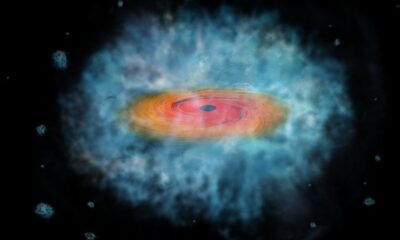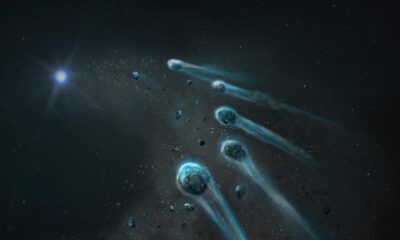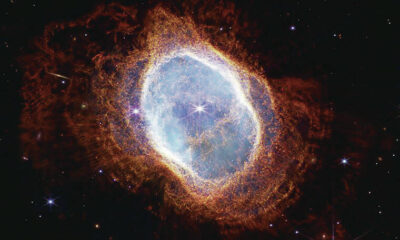Science
Scientists Discover Polarized Light from Exoplanet HD 189733b

Astronomers have made a significant discovery regarding the exoplanet HD 189733b, detecting linearly polarized light that reveals new insights into its atmospheric composition. This research marks a notable advancement in the study of exoplanets by using polarimetry as a method to assess particle composition and size independently of traditional spectroscopic models.
The findings, reported with a confidence level of 7.2σ, indicate that the polarized light was observed in the B band (390 to 475 nm) and peaked near the quarter phase of the planet. The measurements, which showed a polarization of Δp=40.9±7.1 ppm, were obtained using the POLISH2 polarimeter at both the Gemini North Observatory and the Lick Observatory. This breakthrough provides evidence that silicate particles, specifically SiO2 or MgSiO3, with an effective radius of reff=0.038+0.047−0.023 μm, are present in the atmosphere of HD 189733b.
The research aligns with previous results from the Hubble Space Telescope and the James Webb Space Telescope, which also suggested the presence of small silica scattering particles. Notably, the high polarization readings challenge the notion that large polarization and moderate secondary eclipse depth can be explained solely through Rayleigh, silicate, or manganese sulfide (MnS) scattering.
According to the study, the measured polarization of HD 189733b is so pronounced that researchers established a lower limit on its geometric albedo in the B band, placing it at Ag>0.26, with a preferred value of Ag=0.6. This figure exceeds the earlier estimate of Ag=0.226±0.091 derived from Hubble observations, thus designating HD 189733b as one of the most reflective exoplanets known in the B band range.
Furthermore, the findings validate the hypothesis that Rayleigh scattering, rather than contamination from starspots, is responsible for the blue optical slope observed in transmission spectroscopy of HD 189733b. The implications of this discovery extend beyond HD 189733b; researchers estimate that dozens of other known exoplanets could also exhibit detectable polarization with similar atmospheric characteristics, potentially allowing for the identification of these features with a confidence level of at least 5σ after just one week of observation time at Gemini.
The study was conducted by a team led by Sloane J. Wiktorowicz, alongside Pushkar Kopparla and Jiazheng Li. Their work is detailed in a document consisting of 26 pages and includes 22 figures. This research has been accepted for publication in the American Journal and can be accessed online for further review.
This discovery not only enhances our understanding of HD 189733b but also sets a precedent for future studies aiming to unravel the complexities of exoplanet atmospheres. The ongoing exploration of these distant worlds continues to shed light on the diverse conditions that exist beyond our solar system.
-

 Technology5 months ago
Technology5 months agoDiscover the Top 10 Calorie Counting Apps of 2025
-

 Health2 months ago
Health2 months agoBella Hadid Shares Health Update After Treatment for Lyme Disease
-

 Health3 months ago
Health3 months agoErin Bates Shares Recovery Update Following Sepsis Complications
-

 Technology4 months ago
Technology4 months agoDiscover How to Reverse Image Search Using ChatGPT Effortlessly
-

 Technology1 month ago
Technology1 month agoDiscover 2025’s Top GPUs for Exceptional 4K Gaming Performance
-

 Technology2 months ago
Technology2 months agoElectric Moto Influencer Surronster Arrested in Tijuana
-

 Technology5 months ago
Technology5 months agoMeta Initiates $60B AI Data Center Expansion, Starting in Ohio
-

 Technology5 months ago
Technology5 months agoRecovering a Suspended TikTok Account: A Step-by-Step Guide
-

 Health4 months ago
Health4 months agoTested: Rab Firewall Mountain Jacket Survives Harsh Conditions
-

 Lifestyle5 months ago
Lifestyle5 months agoBelton Family Reunites After Daughter Survives Hill Country Floods
-

 Technology4 months ago
Technology4 months agoHarmonic Launches AI Chatbot App to Transform Mathematical Reasoning
-

 Technology3 months ago
Technology3 months agoUncovering the Top Five Most Challenging Motorcycles to Ride



















